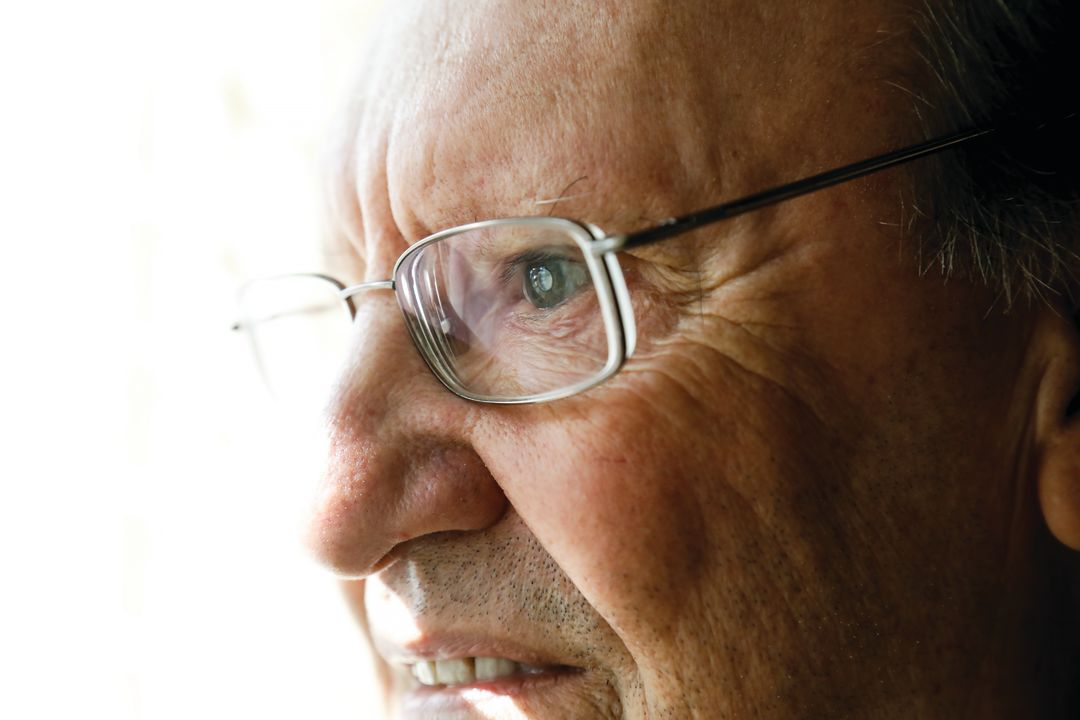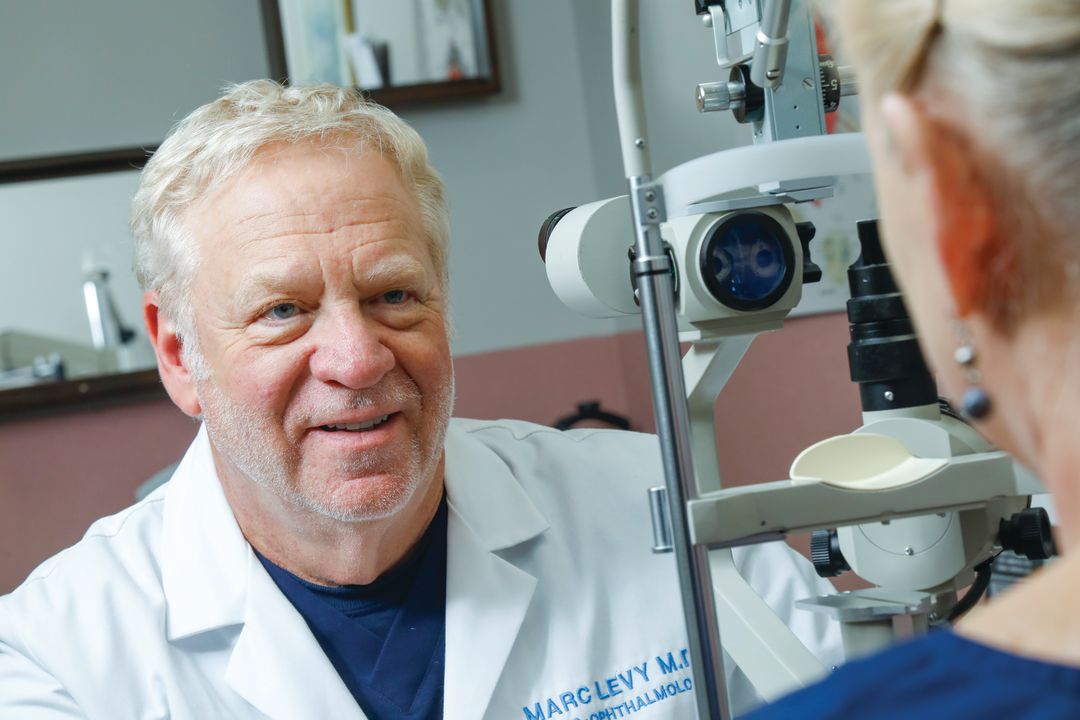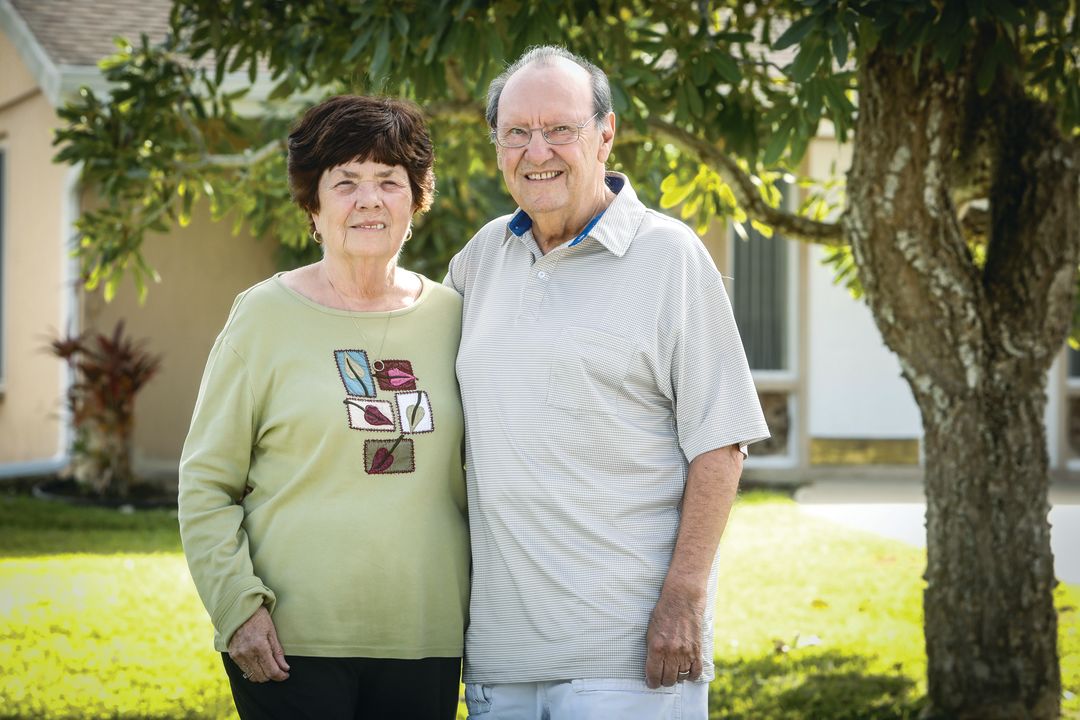
A Tiny Telescope Is Restoring Vision for Macular Degeneration Patients
Going blind wasn’t entirely a surprise for Roger Morrow. His father had lost his sight to advanced age-related macular degeneration (AMD) decades earlier, and Morrow knew the same genetics would eventually catch up to him, too.
A supermarket manager from Michigan, Morrow had never smoked in his life (smoking is a significant risk factor for AMD), and he’d been taking vitamins for decades to stave off the disease. He and his wife, Linda, retired to Southwest Florida to be closer to their children and grandchildren, but throughout their happy, active retirement, Morrow’s vision steadily dimmed.
First, he had to stop driving, but Linda was there to take care of transportation. Then he couldn’t play golf anymore; the ball and tee disappeared before him as he set his stance. He was soon unable to read the sports section of the newspaper without leaning over it with a large magnifying glass, which was for decades virtually the only solution doctors could offer for people losing their vision to this kind of AMD.
“He would get irritated when he couldn’t do things,” Linda remembers. “I think he had it in the back of his head that he was going to go totally blind.”
Morrow, a cheerfully reticent Midwesterner, remembers a matter-of-fact resignation to his fate. “You’re losing your vision,” he said to himself at the time. “That’s it.” Finally, at social gatherings and cocktail parties, Morrow couldn’t recognize his friends and neighbors, even as he stood in front of them and tried to look directly into their eyes. He couldn’t see Linda anymore. He never got to see the face of his youngest grandchild. “They were all dark,” he says.
At age 78, Morrow was legally blind.

Roger Morrow
Image: Chad Spencer
Nearly 11 million Americans have AMD, in which the cells of the macula (the light-sensitive “film” of the eye) break down. It affects the center of a person’s vision, so that the object they most try to focus on becomes the least visible. To replicate the sensation, hold your fists about six inches in front of your eyes; your peripheral vision remains, but you can’t see anything straight ahead.
AMD is a leading cause of irreversible blindness in people over 60. About 90 percent of current AMD cases are “dry” degeneration, which has no approved treatment beyond vitamin supplements, including a popular combo called AREDS2, that may in some cases slow the disease’s progress.
Dry AMD can progress to wet AMD, in which new, brittle blood vessels grow under the retina. While devastating, wet AMD can at least be treated with injections called anti-VEGF (Vascular Endothelial Growth Factor) therapy, which can slow the blood vessel growth and possibly reverse the condition back into dry AMD. But dry AMD could still result in blindness, as it had with Morrow.
“Prior to 1999 the only thing we could do [for enhancing AMD-damaged vision] was give people very, very strong magnifying glasses,” says Dr. Marc Levy of the Sarasota Retina Institute. “They could read, but they had to put the type very, very close to their nose.”
But for the last 20 years, Levy has been active in the development of a new technology so sensational it’s often described in terms of a bionic superhero: In the 1970s TV show, The Six-Million-Dollar Man, Steve Austin had, among his many superhuman implements, a bionic eye with a tiny telescope to enhance his vision.
Four decades later, science fiction has become science fact right here in Sarasota. Levy has been a leading player in a new internationally developed technology that restores vision to patients who are legally blind due to AMD. In the winter of 2018, Morrow, like Austin, was offered the chance to see again, this time through a tiny telescope implanted into one of his eyes.
It was a rare opportunity, decades in the making and available only to a handful of the millions of AMD patients. Fortunately for Morrow and other Sarasotans with AMD, Levy and the Sarasota Retina Institute have been at the forefront of this technology almost from the beginning.
From 2002 to 2004, the Sarasota Retina Institute was one of 28 centers throughout the U.S. participating in FDA surgical trials for this implantable telescope technology (brand name CentraSight) to improve vision and quality of life for people with dry AMD. The area’s demographics, combined with medical specialists like Levy and support from Sarasota Memorial Hospital, make Southwest Florida a prime location for FDA trials involving age-related illnesses. This means locals can have access to medical treatments years before they’re available to the general public.
During that trial period, Levy performed five surgeries in which a miniaturized Galilean telescope (a simple refracting technology similar to opera glasses) was implanted into one eye of patients with advanced dry macular degeneration in both eyes.
While the telescope provides a precise window of clearer vision straight ahead, the eye without the telescope continues to provide peripheral vision. The brain quickly adapts to blend the two images together.
The five-year data from the initial FDA study of the telescope showed that patients on average went from 20/300 vision—legally blind—to about 20/100. Since being approved by the FDA, the procedure is now getting close to achieving 20/40 vision in patients who were previously crippled by AMD. In some states, outcomes may soon get to the point where previously blind patients will be able to drive again (though not in Florida, which currently has driving prohibitions on telescopic lenses).
Despite the procedure’s safety and its demonstrable effectiveness, surgery can be a daunting option. “But I think it was his last choice,” Linda says. “He’d gotten much worse in the last two years.”
Morrow, typically measured, wasn’t sure what to expect, but he was eager for any kind of improvement. “I thought it sounded great,” he says. “At least I’d be able to see something.”

Dr. Marc Levy
Image: Chad Spencer
On a cool day in December 2018, Linda drove Morrow to a Sarasota Memorial Hospital outpatient surgical center to have the telescope implanted by Levy and his team. He was told it could take up to two hours; in the end, it took all of 65 minutes.
Still, he had a long recovery ahead of him. First the eye stayed bandaged; then he wore a protective cup over it. Then there were eye drops, twice a day, for months. “It’s not so bad,” says Morrow. “It doesn’t hurt or anything.”
Slowly, over the weeks, light began to creep in, and then shapes emerged. And finally, familiar faces reappeared.
Looking to the future of this treatment, Levy is now the study investigator for Florida in a new FDA trial testing the telescope technology for AMD patients who previously had cataract surgery. In this case, the intraocular lens (the artificial device that’s implanted after a cataract has been removed) is taken out before the telescope is put in. Patients with intraocular implants had been excluded from the initial CentraSight trial, but if this next version of the procedure is approved, many more people will be able to benefit from the telescope technology. After all, Levy points out, so many people over the age of 60 these days have already had cataract surgery.

Roger and Linda Morrow
Image: Chad Spencer
Far from a $6 million solution for a single bionic man, this microscopic telescope has become a primary weapon in the fight against an epidemic of AMD. It’s already benefited more than 700 patients, Morrow included, and soon may be available for thousands more. Vision, argues Levy, is a quality-of-life issue that affects a person’s whole health.
“If you have better vision, you can go out and walk, you get exercise,” he says. “You live a happier life.”
The sentiment has certainly proved true for Morrow, now 80. “He’s much happier,” Linda says from their home in Port Charlotte. “He can do pretty much anything he wants to do. He can work around the house. He was out in the yard today.”
Morrow has also been able to get back on the golf course again, though his buddies tease him about his “bionic eye.” Best of all, he’s gotten to know his youngest granddaughter’s face. She’s 5 years old now. He can recognize her on sight.